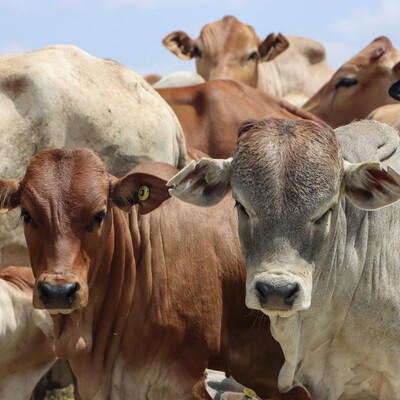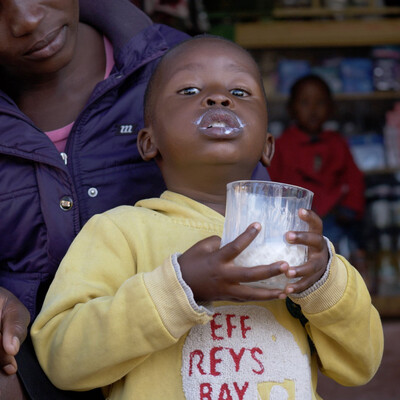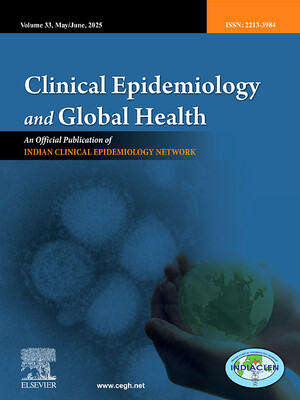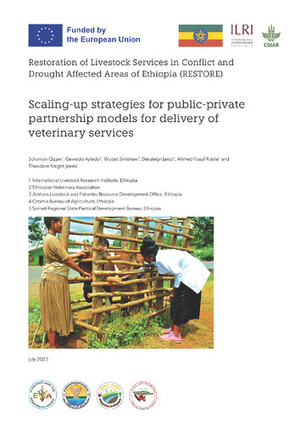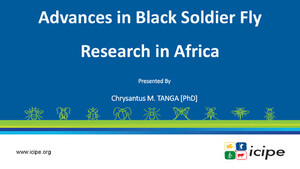
The One Health research-for-development agenda: Enhancing the holistic health of people, animals and environment
Nephew of a dairy entrepreneur near Nairobi, Kenya (photo credit: ILRI/Georgina Smith).
JIMMY SMITH, director general of the International Livestock Research Institute (ILRI), made a slide presentation at a half-day webinar on ‘The place of science in the COVID-19 story’, held on 18 Dec 2020. The webinar brought together leaders of research organizations in the health, agriculture, livestock, public sector, private sector and academia to discuss the COVID-19 pandemic and ways to structure a coherent scientific agenda to tackle it and to manage future disease threats.
The participating organizations in the webinar included leaders from the:
- Kenya Ministry of Agriculture, Livestock and Fisheries
- Kenya Ministry of Health
- Kenya Ministry of Industrialization, Trade and Enterprise Development
- Kenya Medical Research Institute (KEMRI)
- Kenya Agricultural and Livestock Research Organization (KALRO)
- Kenya Department of Veterinary Services (DVS)
- Imperial College London
- International Centre of Insect Physiology and Ecology (ICIPE)
- International Livestock Research Institute (ILRI/CGIAR)
Jimmy Smith’s began his presentation with an overview of the global pandemic. He then outlined the impacts of COVID-19 in Kenya. He ended by discussing the key elements of One Health approaches employed to prevent and control ‘zoonotic diseases’, which are those transmitted between animals and people.
Key messages
- The devastating effects of COVID-19 are impacting every dimension of every society. Such multi-faceted impacts have raised the profile of One Health solutions globally as well as in Kenya.
- The One Health research and development agenda covers everything from research to capacity development to stakeholder engagement and requires engagement and coordination across the animal, human and environment health sectors to prepare for and then to quickly detect (through surveillance) and respond to outbreaks of zoonotic diseases.
> Prepare includes investing in One Health and setting up mechanisms for early disease detection—in animals
> ILRI is undertaking several projects with partners in Kenya to better detect and understand the pandemic and its impacts
> Responses in the One Health sphere include the establishment of ILRI’s One Health Research, Outreach and Education Centre (OHRECA), which has enabled ILRI bioscience laboratories to support MoH for COVID-19 testing and to plan new research and capacity development activities. Responses also need to include deploying the latest bioscience tools to understand viral populations, infection processes and develop universal vaccines for viral families. Not to be overlooked in the response area are solutions to mitigate food-borne diseases and AMR.
- Addressing the present COVID-19 pandemic and preventing future zoonotic pandemics will require relentless focus and unprecedented investment and coordination in One Health.
The scale and costs of the pandemic and zoonoses
The scale and importance of pandemic and endemic zoonotic diseases is hard to overestimate. In just one year, as of 18 Dec 2020, there had been 73.5 million cases of COVID-19, leading to 1.6 million deaths.
Over a single decade, from 1998 to 2009, outbreaks of emerging zoonotic diseases (those that have recently appeared in a population or whose incidence or geographic range is rapidly increasing)—included, in descending levels of importance, severe acute respiratory syndrome (SARS), highly pathogenic avian influenza (HPAI) in Asia, bovine spongiform encephalopathy (BSE), Nipah virus infection, HPAI in Europe, West Nile fever and Rift Valley fever. The cost of these outbreaks was estimated to be USD80.2 billion. The global cost of a ‘mild pandemic’ has been estimated to be in the order of USD600 billion and that of a ‘severe pandemic’ to be USD3 trillion.
Jimmy Smith warned his audience that the frequency of pandemics caused by newly emerging coronaviruses and other zoonotic pathogens has been increasing over the last century. He cited a major report published by his institute, ILRI, and the United Nations Environment Programme in Jul 2020—Preventing the Next Pandemic: Zoonotic Diseases and How to Break the Chain of Transmission—which named seven major human drivers of the emergence of zoonotic diseases. They are:
- increasing demand for animal protein
- unsustainable agricultural intensification
- increased use and exploitation of wildlife
- unsustainable utilization of natural resources
- travel and transportation
- changes in food supply chains
- climate change
An additional disease burden in tropical and subtropical countries of the developing world, where some one billion people depend on—and often live in close proximity to—their livestock are the endemic zoonotic and other livestock diseases, such as pests des petits ruminants (PPR), foot-and-mouth disease and bovine tuberculosis.
These endemic diseases, which have a near-constant presence in a population, can not only sicken people but can also devastate the livelihoods of the poor by sickening and killing their precious animal stock, which are often the most important asset poor households own.
Women are heavily affected by these endemic livestock diseases, because two-thirds of the world’s rural livestock keepers are women.
Costs of COVID-19 in Kenya
Taking Kenya as an example, Smith explained the large impacts of zoonotic diseases are due to the large extent on which the country and its economy depend on livestock. The sector supports a signification portion of the country’s agricultural workforce, provides 13% of Kenya’s gross domestic product and provides millions of people not only with food but also with jobs, income and resilience against shocks.
A phone survey ILRI conducted in northern Kenya, where many pastoral livestock herders live, helped to assess the many financial and other costs of COVID-19 across the livestock value chain, which includes agrovets and other livestock service providers, livestock aggregators, and the producers, processors, distributors and consumers of livestock products.
The impacts on consumers, for example, included reduced purchasing power due to fewer livestock sales and unemployment, less food consumed/food security, and less use of health and nutrition services. Specifically, there was:
- A significant reduction in household incomes
- Reduced consumption of nutrient-dense meat, eggs, fruits and vegetables
- Fewer and smaller meals consumed each day
- Fewer ante- & post-natal visits (e.g., in Garissa, the percentage of children from 6 months to nearly 5 years old getting micronutrient supplementation dropped from 71% in May 2019 to 30% in May 2020)
- On the positive side, the frequent hand washing and sanitation brought about by COVID-19 preventive measures are likely to have positive health/nutrition effects.
The impacts of COVID-19 on livestock markets and retailers in northern Kenya included fewer animal sales and higher international trade costs due to border closures and livestock movement restrictions. Specifically, there was:
- A sharp reduction in the amount of meat sold and a decline in the volumes of livestock sold, which plummeted in March and April 2020 with the closure of most livestock markets and then improved somewhat the following May and June but remained stagnant compared to sales in the period before the pandemic.
One Health: Key Elements
The watchwords of the One Health approach to preventing and controlling zoonotic pandemics are prepare, detect and respond. The three sectors united in One Health approaches are human health, animal health and environment health.
Prepare
To prepare for zoonotic disease outbreaks, we must first invest in One Health, said Smith. And invest appropriately.
Detect
We must be able to detect outbreaks early because, Smith explained, the cost of controlling these diseases rises exponentially over even short periods of time—from the first exposure and clinical signs of disease appearing in animals to exposure and clinical signs first showing up in humans to people seeking medical care. The USD84-billion cost of zoonoses and food borne diseases each year includes USD25 billion lost due to animal deaths, USD9 billion due to productivity losses and USD50 billion due to healthcare treatments needed by people.
Smith detailed a few projects that are evaluating the opportunities as well as impacts of lockdown measures implemented in Kenya.
Underway, he said, is a ‘One Health Regional Network for the Horn of Africa (HORN) project funded by the UK, and led by ILRI and the University of Liverpool. This project, a partnership with the University of Nairobi and Moi University, is assessing the status of public health actions against COVID-19 in a slum in Nairobi.
Another team of young multidisciplinary co-investigators from Moi University is determining the impacts of COVID-19 impacts and the mitigation measures employed against it on dietary diversity and health outcomes in Kenya’s Uasin Gishu County.
ILRI and its partners have also repurposed some funding to conduct telephone surveys of formal and informal livestock value chain actors, including the business implications of the lockdown of businesses, financing issues and farmers.
ILRI is also analysing respiratory virus and bacteria shedding in exhaled breath and mass masking behaviour in a Kenyan community. Acknowledging that knowledge, attitudes and perceptions influence the behaviour and practices of mask wearing in individuals across different socio-economic strata, this pilot study aims to determine the presence of SARS-CoV-2 virus on masks.
Respond
ILRI has repurposed some of its first-class biosciences laboratory facilities to support the Kenya Ministry of Health’s COVID-19 testing and research work. Between 1 June and mid-November 2020, ILRI staff have conducted more than 22,446 COVID-19 tests, of which nearly 3,000 were positive.
In the latter part of 2020, a One Health Research, Outreach and Education Centre (OHRECA) was established at ILRI’s Nairobi headquarters with German funding. OHRECA will be helping to conduct and coordinate new One Health research and to build local capacity in this multidisciplinary, multi-sectoral field.
Among OHRECA’s new research work is the following:
- Monitoring the circulation of SARS-CoV-2 in communities through sewerage water surveillance.
- Investigating the genetic evolution and transmission dynamics of SARS-CoV-2 virus isolates from different parts of the country through whole genome sequencing.
- Profiling the B-cell-receptor repertoire from patients showing varied disease outcomes to identify neutralizing antibodies for potential production of recombinant antibody therapeutics.
Among OHRECA’s capacity development work is the following:
- A regional workshop was held in Jan 2021 to review a training strategy for One Health.
- 12 graduate fellows from East Africa started work towards their doctoral degrees in Feb 2021.
- Public health and animal health officials are being trained in One Health principles to support the surveillance and control of zoonotic diseases.
- Initial ‘training of trainers’ was completed in Uganda on use of communications to help change behaviour in ways that improve food safety; this training is now being scaled up in Kenya and Ethiopia through Vétérinaires sans Frontìeres—Germany.
- Communications and messages are being developed and disseminated to sensitize individuals and publics on best practices in use of antibiotics in livestock systems to stem the rise in antimicrobial resistance in pathogens.
There is great need for expertise in biological sciences to respond quickly and effectively to zoonotic outbreaks. Only biological understanding and skills will help us to:
- Understand viral populations:
> conduct smart ‘molecular surveillance’ of pathogens
> perform whole-genome sequencing of viruses
- Understand the processes of infection by identifying:
> the molecular interactions that permit pathogens to ‘jump’ from one species to another
> the potential animal reservoirs of the pathogens causing pandemics
- Develop universal vaccines against viral families with pandemic potential to control those viruses within their animal reservoirs.
Responding to zoonoses also entails minimizing the risks and hazards of food-borne pathogens and diseases found in the fresh food markets all around the world, from the ‘farmers’ markets of high-income countries to the ‘wet’, ‘traditional’ or ‘informal’ markets of low-income countries. ILRI’s approach to improving the safety of food processed and sold in the ubiquitous informal markets of developing countries is not to prohibit these markets, which, after all, supply 80% of the food most people buy and consume, but rather to help establish ‘enabling’ regulatory environments, to implement simple technology improvements, to train food sellers in good food safety practices, and to provide the sellers with incentives for adopting those practices.
Conclusion
The classical approach to responding to zoonotic disease outbreaks in livestock has traditionally entailed enlisting animal health expertise only and to combat one disease at a time. What is needed, Smith concluded, is an integrated approach enlisting support from grassroots groups to ministries to regional and global organizations and coordinating work across human health, animal health, tourism, trade and other sectors.







